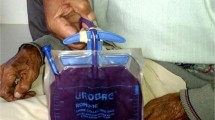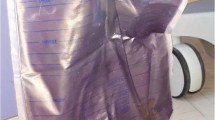Abstract
Purple urine bag syndrome (PUBS) is a unique phenomenon characterized by purple discoloration of the urinary catheter bag and tubing following urinary catheterization lasting for hours to days. The purple discoloration is a mixture of indirubin dissolved in plastic with indigo on its surface. PUBS is most commonly associated with urinary tract infection (UTI) caused by bacteria with indoxyl phosphatase/sulfatase activity. It occurs predominantly in chronically catheterized, constipated elderly female patients. It usually appears to be asymptomatic and harmless, but rarely it can present as a severe illness. We report on a 29-year-old female with urinary ileal diversion presenting with multiple episodes of PUBS each with an asymptomatic state of varying severity, symptomatic UTI and severe sepsis requiring intensive care. To our knowledge, this is the first report where a single young patient had recurrent PUBS which presented with a full spectrum of disease severity at different occasions.


Similar content being viewed by others
References
Barlow GB, Dickson JAS. Purple urine bags. Lancet. 1978;311:220–1.
Dealler SF, Hawkey PM, Millar MR. Enzymatic degradation of urinary indoxyl sulfate by Providencia stuartii and Klebsiella pneumoniae causes the purple urine bag syndrome. J Clin Microbiol. 1988;26:2152–6.
Yang CJ, et al. Chronic kidney disease is a potential risk factor for the development of purple urine bag syndrome. J Am Geriatr Soc. 2009;57:1937–8.
Mantani N, et al. A case-control study of purple urine bag syndrome in geriatric wards. J Infect Chemother. 2003;9:53–7.
Shiao CC, et al. Purple urine bag syndrome: a community-based study and literature review. Nephrology. 2008;13:554–9.
Su FH, et al. Case analysis of purple urine-bag syndrome at a long-term care service in a community hospital. Chang Gung Med J. 2005;28:636–42.
Hadano Y, et al. An update on purple urine bag syndrome. Int J Gen Med. 2012;5:707–10.
Tasi Y-M, et al. Purple urine bag syndrome, not always a benign process. Am J Emerg Med. 2009;27:895–7.
Bhattarai M, et al. Purple urine bag syndrome may not be benign: a case report and brief review of the literature. Case Rep Infect Dis. 2013;2013:863853.
Ga H, Kojima T. Purple urine bag syndrome. JAMA. 2012;307:1912–3.
Chung SD, Liao CH, Sun HD. Purple urine bag syndrome with acidic urine. Int J Infect Dis. 2008;12(5):526–7.
Lin CH, et al. Purple urine bag syndrome in nursing homes: ten elderly case reports and a literature review. Clin Interv Aging. 2008;3:729–34.
Yaqub S, Mohkum S, Mukhtar KN. Purple urine bag syndrome: a case report and review of literature. Indian J Nephrol. 2013;23:140–2.
Khan F, et al. Purple urine bag syndrome: an alarming hue? A brief review of the literature. Int J Nephrol. 2011;2011:419213.
Nicolle LE, Infectious Diseases Society of America; American Society of Nephrology, et al. American Geriatric Society. Infectious Diseases Society of America guidelines for the diagnosis and treatment of asymptomatic bacteriuria in adults. Clin Infect Dis. 2005;40:643–54 (Erratum in: Clin Infect Dis., 2005 40:1556).
Ben-Chetrit E, Munter G. Purple urine. JAMA. 2012;307:193–4.
Johnson JR. Purple urine bag syndrome. JAMA. 2012;307:1913.
Author information
Authors and Affiliations
Corresponding author
Ethics declarations
Conflict of interest
The authors have declared that no conflict of interest exists.
About this article
Cite this article
Lin, J., Hlafka, M., Vargas, O. et al. Recurrent purple urine bag syndrome presenting with full spectrum of disease severity: case report and review of literature. CEN Case Rep 5, 144–147 (2016). https://doi.org/10.1007/s13730-016-0213-6
Received:
Accepted:
Published:
Issue Date:
DOI: https://doi.org/10.1007/s13730-016-0213-6




